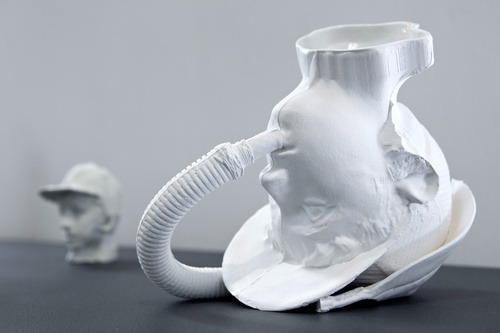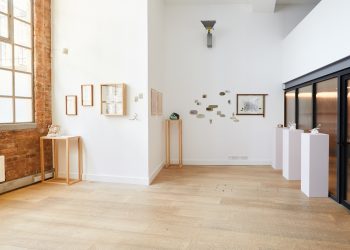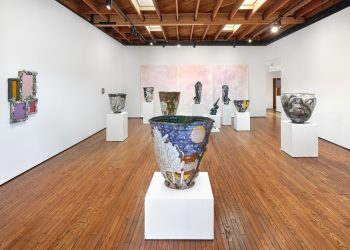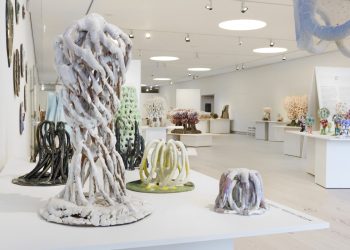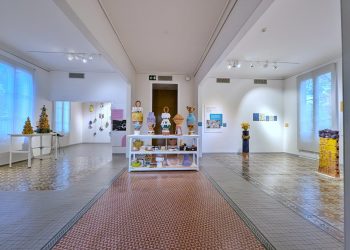
HYPERCLAY: Contemporary Ceramics / Gladstone Regional Art Gallery & Museum, Gladstone, Australia
December 13, 2013 – March 2014, 2014
RoHYPERCLAY: Contemporary Ceramics investigates the field of ceramics, focusing on new attitudes, techniques and technologies that are being embraced by artists in the 21st century. Walter Auer, Roderick Bamford, Stephen Bird, Jacqueline Clayton, Andrea Hylands, Addison Marshall, Pip McManus and Paul Wood all ignite the imagination with the potential of clay through their work. As the prefix ‘hyper’ suggests, HYPERCLAY presents clay-based work where the medium has been amplified, extended and intensified to produce work that will delight, provoke and surprise. New technologies, the process of making, and the re-purposing of materials to create new forms are the delicate threads that bind the works in HYPERCLAY together.
A collection of 35 short videos have been produced to accompany the work in HYPERCLAY. These include interviews with the artists, curators, academics, collectors, gallerists and students. All videos are available to view through iPads in the exhibition space, offering the viewer different perspectives on the works as well as deeper, richer connections to the artists.
Roderick Bamford explores the process of additive fabrication, creating a series of ceramic sculptures using a modified rapid prototyping printer. Bamford sourced the parts for his 3D printer online, gradually building a machine that could print with clay. The result is a device that affords Bamford an expanded making process that incorporates both analogue and digital techniques.
Stephen Bird, better known for his satirical figurative ceramics, presents two works that also play at the intersection of the digital and the handmade. Wanting to reveal the sequence of events that takes place when transforming raw clay into a finished sculpture, Bird spent several intensive weeks in his studio creating the stop-frame clay animation What are you laughing at?. The work is a re-telling of the Creation Story through the lens of the post-industrial world. It also documents Bird’s making process, capturing it as performance. Similarly, I Just Don’t Believe in Ceramics elevates ceramic surface decoration from static and permanent to evolving virtual design.
New Warriors by Andrea Hylands captures the performance of material itself. Her fragile forms are the product of bone china slip poured into a mould and then removed at varying durations. This process is a balance between the spontaneity of movement and material, and the precision of the artists’ hand.
Ceramicist Walter Auer is interested in the transformation and preservation of objects through a petrifaction process that he has been experimenting with for nearly 10 years. Auer soaks discarded soft toys in watered-down clay (terra sigillata) for weeks – even months – before submitting them to a grueling firing process.
Similarly, Pip McManus is interested in transformation. Combining clay, video, sand and water, McManus has created a video work entitled Watershed 2 that engages with ideas of permanence and organic forms. In Watershed, the ancient medium of clay is effortlessly in conversation with the contemporary medium of video.
Paul Wood scours op shops, thrift stores and neighbourhood gardening centres for pre-loved ceramic objects that he then re-fires, melts and slumps to create dramatic new sculptures. For Guardians of a Goddess Wood has crafted an ode to the ornamental water features that proudly sat in the neighborhood gardens of his childhood.
Addison Marshall creates works that explore form, colour, and tension. Toothpicks, fluorescent cotton thread and skewers are meticulously hand woven through punctured clay discs. The final pieces echo relationships and intimacy, with the clay literally leaning on the humble materials for stability and support.
Jacqueline Clayton’s Rilke and the Autoclave is part of a sequence of work produced by the artist that moulds porcelain and face powder into flowers, conjuring associations with the feminine ideal. Displayed in scientific glassware on an antique steriliser unit, Rilke and the Autoclave highlights how certainty is established through classification and order.
HYPERCLAY: Contemporary Ceramics was first shown at Object Gallery in 2012 and toured to 12 venues nationally until 2014.
Hours: Monday to Saturday, 10 am – 5 pm. Free admission.
CONTACT
Gladstone Regional Art Gallery & Museum, gragm@gladstonerc.qld.gov.au
Tel. (07) 49766766
Object Gallery, gallery@object.com.au
Tel. +61 2 9361 4555
Gladstone Regional Art Gallery & Museum
136-144 Goondoon St
Gladstone QLD 4680
Australia
www.gallerymuseum.gladstonerc.qld.gov.au
Above: Roderick Bamford, Fuddling Manoeuvre, 2011, Bone china, clay waste, 28x20x20 cm. Photo by Jamie Williams.
> More exhibitions / View the list of ceramic art exhibitions


